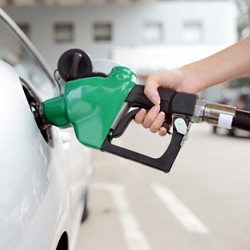Unfortunately, there’s not much we can do to control the price at the pump, but don’t worry, there are ways to increase fuel efficiency and get the most of each tank of gas. Use these tips for more mileage between fill-ups as well as more money in your pocket.
Get Better Fuel Efficiency
How to Save at the Pump
- Get regular tune-ups
- Keep tires properly inflated
- Maintain proper tire alignment
- Slow down
- Brake less
- Reduce air conditioner use

Care for Your Car
Get regular tune-ups to be sure you’re not losing on fuel economy. Some vehicle problems can seriously decrease your fuel economy and should be taken care of. Replacing a faulty oxygen sensor, for example, can improve gas mileage by up to 40%!
Keeping tires properly inflated also helps conserve fuel and money. Gas mileage can be lowered up to 0.3% for every half kilogram drop in pressure in all four tires if they are underinflated. Check every month that all your tires (even your spare) meet the vehicle manufacturer’s recommended tire pressure listed in your vehicle owner’s manual. RRemember to check pressure when the tires are cold, meaning the vehicle has been parked for at least three hours or has driven less than 2 km at moderate speeds.
Keeping tires correctly aligned improves gas mileage as well as helps the tires wear evenly, extending their life. Tires that are improperly aligned can result in as much as a 10% decrease in fuel efficiency, meaning more money out of your pocket spent on wasted gas.
Drive with Diligence
Slow down! Consider this: Each vehicle reaches its optimal fuel economy at different speed ranges but usually gas mileage begins to quickly diminish at speeds above 80km/h.
Brake less. Every time we step on the brakes, we’re essentially wasting the acceleration we’ve already gained. By anticipating the need to stop and coasting a bit before coming to a standstill, we can make the most of the car’s momentum.
While many factors affect fuel economy in hot weather, running your vehicle’s air conditioning and open windows are two big contributors. To help offset this (and keep your passengers comfortable!) we recommend rolling your windows down at low speeds to keep cool and run your air conditioning when traveling at highway speeds.
Go the Extra Mile with Ecopia
Buying a more fuel efficient tire is one more way to increase fuel economy. Specially engineered with low rolling resistance, Bridgestone Ecopia tires minimize wasted energy, reducing fuel consumption by up to 7.5 litres every month when compared with a conventional tire. A low rolling resistance tire will go further than a conventional tire with the same amount of energy input. Find the low rolling resistance Ecopia tire for your car, and start saving!*
*Fuel savings estimated based on lab testing Ecopia EP422 vs. Turanza EL400. Actual road savings may vary based on tire pressure, tread life, vehicle, driving style and road conditions.
-
My TPMS Light Came On - What Does it Mean?
My TPMS Light Came On - What Does it Mean?
The TPMS warning light will help warn you when your tire pressure is too low and could create unsafe driving conditions. Do you know what to do next?
Learn More -
What are the car tire parameters and notes for drivers
What are the car tire parameters and notes for drivers
What specification does a car tire include and why is it important to know the tire specifications?
Learn more -
Should we install a tire pressure monitoring system for our car
Should we install a tire pressure monitoring system for our car
What is a tire pressure monitoring system (TPMS)? Types of tire pressure monitoring systems and advantages of installing them.
Learn more
*Based on rolling resistance in lab testing comparing Ecopia EP422 Plus (215/60R16 95T) to Firestone FR710 (P215/60R16 94T) when new (excludes original equipment tires). Actual results may vary based on proper tire maintenance, vehicle, driving style and road conditions.
-
My TPMS Light Came On - What Does it Mean?
My TPMS Light Came On - What Does it Mean?
The TPMS warning light will help warn you when your tire pressure is too low and could create unsafe driving conditions. Do you know what to do next?
Learn More -
What are the car tire parameters and notes for drivers
What are the car tire parameters and notes for drivers
What specification does a car tire include and why is it important to know the tire specifications?
Learn more -
Should we install a tire pressure monitoring system for our car
Should we install a tire pressure monitoring system for our car
What is a tire pressure monitoring system (TPMS)? Types of tire pressure monitoring systems and advantages of installing them.
Learn more